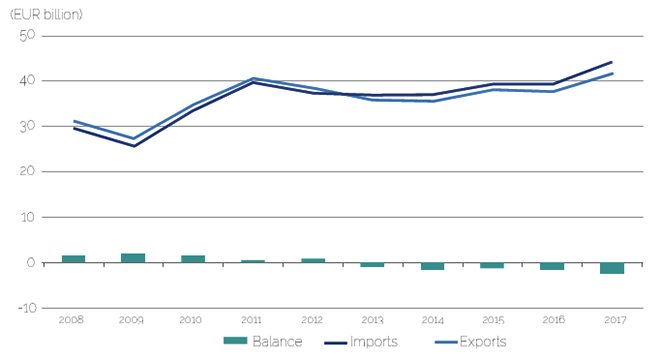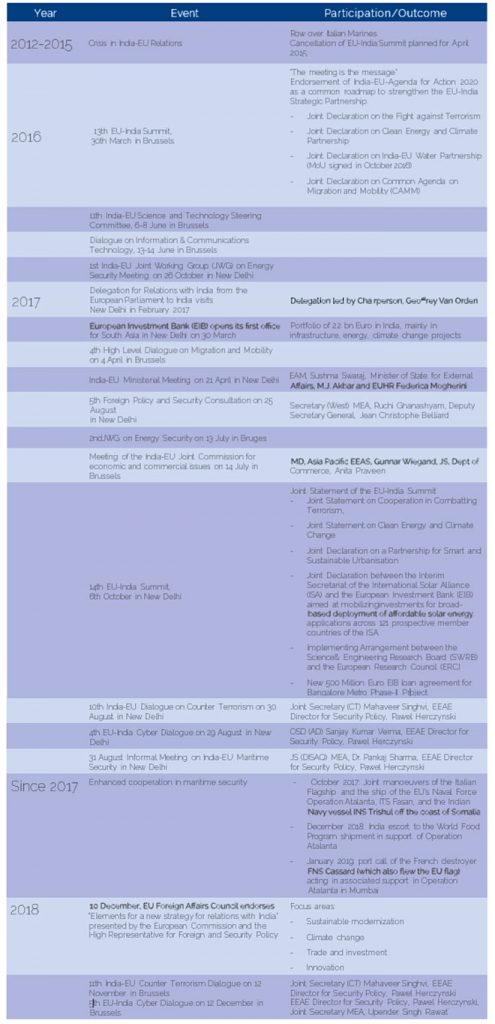-
CENTRES
Progammes & Centres
Location

Five years ago, the relations between India and the European Union (EU) reached rock-bottom, although there seemed hardly a reason for it given the convergence of interests between the two major powers.
Negotiations about a free trade agreement had long been stalled when the infamous case of the Italian marines<1> in 2012 caused the souring of relations between India and Italy. When Federica Mogherini, a former foreign minister of Italy became the EU’s High Representative for Foreign Affairs in 2014, the crisis caused by the case of the two Italian soldiers who allegedly killed two Indian fishermen off the coast of Kerala, reached EU level. The situation worsened to the point that the planned EU-India summit in April 2015 failed to materialise.
Much has changed since then, and India and the EU are currently experiencing a revival of their relations. Although many questions remain open, a flurry of activities under the government of Prime Minister Narendra Modi and EU High Representative Federica Mogherini have brought relations back on track. It is a development that is as much a result of shared interest in a quickly changing international environment as a “commendable combination of political pragmatism and diplomatic skills on both sides,” as senior Indian diplomat Bhaswati Mukherjee put it.
It is too early to assess the outcome of many newly planned common projects. The fact, however, that a large number of high-level meetings and dialogues accompanied by joint declarations and statements have taken place in the past few years, shows that the strategic partnership is back to life. The 13th EU-India Summit in March 2016 in Brussels<2> (the first summit after a gap of four years) endorsed the India-EU-Agenda for Action 2020<3>and presented a clear roadmap for the next five years of the strategic partnership.
The Agenda for Action 2020 is a comprehensive document that starts with the area that saw most progress in the past few years: foreign and security policy. It mentions (amongst others) cooperation in counter-terrorism, cyber security and maritime security and coordination in international fora though “regular dialogues” between the Indian Ministry of External Affairs (MEA)
and the European External Action Service (EEAS). The agenda also makes explicit mention of many of Prime Minister Modi’s favourite projects: the “Clean India,” “Clean Ganga,” “Smart Cities,” “Digital India” and the “Make in India” campaigns. Four Joint Declarations specify areas of cooperation—“the fight against terrorism,”<4> “clean energy and climate partnership,”<5> “water partnership,”<6> and a “common agenda on migration and mobility”<7> (CAMM). As a follow-up, a Memorandum of Understanding (MoU) on an “India-EU Water Partnership”<8> was signed in October 2016. A high-level dialogue on migration and mobility took place in April 2017 in Brussels.
However, the much-delayed Bilateral Trade and Investment Agreement (BTIA)<9> was conspicuously absent in the documents. Even two meetings of senior officials in 2017 and 2018 and three rounds of technical talks on specific roadblocks did not lead to a breakthrough; some observers perceive this to be “an embarrassment.”<10> Ambassador Bhaswati Mukherjee has said that relevant Indian ministries are currently “of the view that the BTIA at present is of no benefit for India,” although both sides remain important trade partners and the volume of trade continues to increase (See Figure 9).
Aside from this, the 14th EU-India Summit in October 2017 in Delhi<11> showed that the process of regular consultations and dialogue is back on track. It specified and deepened many areas of cooperation that were identified at the previous summit. Three Joint Statements were agreed upon: “cooperation in combatting terrorism,”<12> “clean energy and climate change,”<13> and a “partnership for smart and sustainable urbanization.”<14> These were followed- up in 2018 by new rounds of “counter-terrorism dialogue,” “cyber dialogue,” an informal meeting on “maritime security,” as well as some first steps towards military cooperation. Joint manoeuvres (PASSEX) of the Italian flagship of the EU’s Naval Force Operation Atalanta ITS Fasan and the Indian Navy vessel INS Trishul off the coast of Somalia have taken place in 2017. They were followed- up in December 2018 by an Indian escort to the UN’s World Food Program vessels and in January 2019 by a port call in Mumbai of the French destroyer FNS Cassard (which also flew the EU flag) acting in associated support with the EU anti-piracy-operation “Atalanta.”
Figure 9: EU–India Imports, Exports and Balance of Trade in Goods (2008–17)
 Source: Eurostat (online data code: ext_lt_maineu)
Source: Eurostat (online data code: ext_lt_maineu)In the area of climate change and energy, both sides plan to cooperate further through the India-led International Solar Alliance (ISA). In March 2018, the European Investment Bank (EIB) and the Indian Renewable Energy Development Agency (IREDA) signed a loan agreement of over 150 million Euros for financing renewable energy in India. Earlier in 2017, the EIB had opened its first office in South Asia in New Delhi.
Another milestone was the presentation of the EU’s “Elements of a new strategy for relations with India”<15> by High Representative Federica Mogherini in December 2018. The document recommends “the EU and India should consider the negotiation of a broader Strategic Partnership Agreement.” With the elections in both the EU and India having been conducted in early 2019, the challenge will be for both sides to keep the positive momentum alive and not to miss the forest for the trees that have been flagged in the numerous common documents produced over the past few years. A free trade agreement would be especially beneficial in the wake of a new global economic downturn. The time for India and the EU is now.
Table 3: A Timeline of India-EU Engagement, 2014-19
 Note: Major events highlighted in darker blue. Sources: European Union, Indian Embassy (Brussels)
Note: Major events highlighted in darker blue. Sources: European Union, Indian Embassy (Brussels)This article originally appeared in special report Looking Back looking Ahead.
<1> Aathira Konikkara, “Modi’s Forgotten Promise of Justice for The Kerala Fishermen in the Italian Marines Case,” Caravan Magazine, 13 May 2019.
<2> “India-EU Joint Statement on the 13Th India-EU Summit, Brussels,” Ministry of External Affairs, Government of India, 31 March 2016.
<3> “EU-India Agenda for Action-2020, Brussels,” Ministry of External Affairs, Government of India, 2016.
<4> “India-EU Joint Declaration on the Fight Against Terrorism,” Ministry of External Affairs, Government of India, 2016.
<5> “EU and India Agree on Clean Energy and Climate Partnership,” European Commission, 31 March 2016.
<6> “India-EU Water Partnership,” IEWP, 2016.
<7> “Joint Declaration on a Common Agenda on Migration and Mobility between India and the European Union And Its Member States,” European Union, 2009.
<8> “India-EU Water Partnership,” EIP Water, 2016.
<9> Amiti Sen, “India-EU Attempts to Re-Start Free Trade Talks Stumble on Old Issues,” The Hindu Businessline, 7 December 2018.
<10> Bhaswati Mukherjee, “Chapter 10,” India and EU: An Insider’s View (New Delhi: Indian Council of World Affairs, 2018).
<11> Ester Arauzo-Azofra and Preben Aamann, “EU-India Summit, New Delhi, 06/10/2017,” Council of the European Union.
<12> “India-EU Joint Statement on Combating Terrorism,” Council of the European Union, 6 October 2017.
<13> “EU-India Joint Statement on Climate Change,” Council of the European Union, 6 October 2017.
<14> “Joint Declaration between the European Union and the Republic of India on a Partnership for Smart & Sustainable Urbanisation,” Council of the European Union.
<15> “Joint Communication: Elements of an EU Strategy on India,” European External Action Service, 20 November 2018.
The views expressed above belong to the author(s). ORF research and analyses now available on Telegram! Click here to access our curated content — blogs, longforms and interviews.

Rachita Misra Associate Director (Knowledge and Advocacy) SELCO Foundation
Read More +